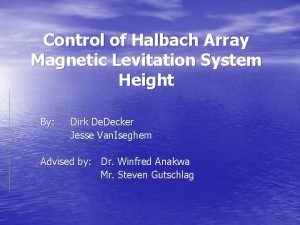Calculations of Neoclassical Viscous Damping on Flux Surfaces

- Slides: 1

Calculations of Neoclassical Viscous Damping on Flux Surfaces Near Magnetic Islands in HSX S. P. Gerhardt*, J. N. Talmadge and D. T. Anderson, HSX Plasma Laboratory, U. of Wisconsin, Madison *Present 0. Contents: • Configuration Flexibility in HSX • Viscous Damping Near Magnetic Islands • The Four Configurations of HSX under Study • The Hamada Spectrum in these Configuration • Enhanced Viscous Damping in the Vicinity of a Magnetic Island 1. Configuration Flexibility in HSX Many Different Configurations are Accessible with the Auxiliary Coils Employer: Princeton Plasma Physics Laboratory 2. Viscous Damping Near Magnetic Islands Change the Path of a Field Line ØSymmetry propertied are determined by the path of a magnetic field line through the |B| variation. 3. Four Configurations of HSX 4. The Hamada Spectrum is Modified Near an Island QHS: Standard Configuration with 12/11 Resonance QHS: Small Symmetry Breaking in Vicinity of 12/11 ØNear a magnetic island, the magnetic surfaces are distorted. 10 Largest Spectral Components at r/a=0. 93. Islands Exist: 0. 931<r/a<0. 961 ØHence, the field line path is changed near the magnetic island. Solve the Momentum Balance Equations on a Magnetic Surface Poloidal and Parallel Momentum Balance 2% Hill, Transform Lowered To Avoid 12/11 Resonance - - N 12 Mirror + - - Broad N Mirror + - + + - - + - + Hill + + + + - Slower Damping Rare is Changed in Vicinity of Magnetic Island + + + Percentage indicates the ratio of amp-turns in the two coil sets. Use Linear Neoclassical Viscosities for the Plateau Regime Plateau Viscosities From Shaing, Hirshman, and Callen, 1986 Configurations Discussed In This Poster: QHS: Standard Quasisymmetric Configuration of HSX Viscosity Coefficients Are Calculated From Hamada Spectrum 6% Hill, Transform Lowered to include 4/4 Resonance 6% Hill, Large Symmetry Breaking near 4/4 Resonance 10 Largest Spectral Components at r/a=0. 37 Islands Exist: 0. 375<r/a<0. 661 Hill: Lowers Rotational Transform, Places Plasma on Magnetic Hill Mirror: Large Toroidal Mirror (m=0, n 0) Spectral Component is Present and Rotational Transform is Slightly Raised Rotational Transform Profiles Indicate the Resonances 2% Hill, No Low Order Resonaces 10 Largest Spectral Components at r/a=0. 8 No Resonances with n<16, where /2 =n/m Represent the Magnetic Field Through The Hamada Spectrum + + + - Symmetry Breaking Increases Near the Magnetic Islands ØThis results in symmetry breaking on surfaces near the magnetic island. Ampere’s Law N 4 Mirror (Standard) 5. The Viscous Damping is Increased Near the Island Modeling Gives Rise to Two Damping Rates ØThe two rates correspond to the damping of flows in two directions on a magnetic surface ØThe constants here are defined as: 14% Mirror: Large Toroidal Ripple and 8/7 Resonance Faster Damping Rare is Strongly Affected in Vicinity of Magnetic Island 14% Mirror: Toroidal Mirror Swamps Island Induced Effects 10 Largest Spectral Components at r/a=0. 88 Islands Exist: 0. 883<r/a<0. 949 This is expected to be the strongest experimental signature. These results accepted for publication in Physics of Plasmas

